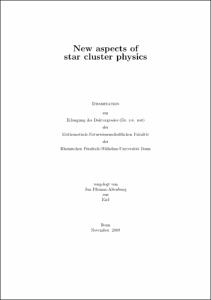New aspects of star cluster physics

New aspects of star cluster physics

| dc.contributor.advisor | Kroupa, Pavel | |
| dc.contributor.author | Pflamm-Altenburg, Jan | |
| dc.date.accessioned | 2020-04-15T10:28:37Z | |
| dc.date.available | 2020-04-15T10:28:37Z | |
| dc.date.issued | 22.07.2010 | |
| dc.identifier.uri | https://hdl.handle.net/20.500.11811/4495 | |
| dc.description.abstract | Star clusters are the birth-sites of both low- and high-mass stars and can be considered to be the building blocks of galaxies. Therefore, the understanding of the formation, evolution, and death of star clusters is of fundamental importance for the understanding of galaxy evolution. This thesis focuses on several new aspects of star cluster physics: For a long time the stellar populations of star clusters were believed to be single aged populations. But recent observations have cast a doubt on this simple picture. Based on these observations this thesis shows that i) the capture of older field stars during star cluster formation can mimic apparently prolonged star formation, and that ii) gas accretion by massive star clusters can account for multiple stellar populations. Because massive stars are, despite their short life times of only a few Myr, the driving engines for galactic evolution, the process which releases them from the star clusters to the galactic field must be understood. This is problem iii) addressed in this thesis: iiia) The decay of few-body groups of massive stars formed in star clusters, iiib) a new ejection process combining the dynamical and the supernova ejection process of massive stars, and iiic) the large scale dispersion of massive stars. | en |
| dc.language.iso | eng | |
| dc.rights | In Copyright | |
| dc.rights.uri | http://rightsstatements.org/vocab/InC/1.0/ | |
| dc.subject | N-Körper-Simulationen | |
| dc.subject | interstellares Medium | |
| dc.subject | ISM | |
| dc.subject | Supernovas | |
| dc.subject | Doppelsterne | |
| dc.subject | Orion-Nebel | |
| dc.subject | ONC | |
| dc.subject | Gasakkretion | |
| dc.subject | N-body simulations | |
| dc.subject | inter stellar medium | |
| dc.subject | supernovae | |
| dc.subject | binaries | |
| dc.subject | Orion Nebular cluster | |
| dc.subject | gas accretion | |
| dc.subject.ddc | 520 Astronomie, Kartografie | |
| dc.title | New aspects of star cluster physics | |
| dc.type | Dissertation oder Habilitation | |
| dc.publisher.name | Universitäts- und Landesbibliothek Bonn | |
| dc.publisher.location | Bonn | |
| dc.rights.accessRights | openAccess | |
| dc.identifier.urn | https://nbn-resolving.org/urn:nbn:de:hbz:5N-11972 | |
| ulbbn.pubtype | Erstveröffentlichung | |
| ulbbnediss.affiliation.name | Rheinische Friedrich-Wilhelms-Universität Bonn | |
| ulbbnediss.affiliation.location | Bonn | |
| ulbbnediss.thesis.level | Dissertation | |
| ulbbnediss.dissID | 1197 | |
| ulbbnediss.date.accepted | 09.06.2010 | |
| ulbbnediss.fakultaet | Mathematisch-Naturwissenschaftliche Fakultät | |
| dc.contributor.coReferee | Langer, Norbert |
Dateien zu dieser Ressource
Das Dokument erscheint in:
-
E-Dissertationen (4337)




